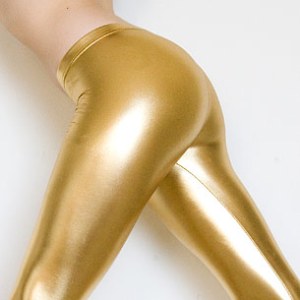[caption id="attachment_166" align="aligncenter" width="300" caption="I\'m not kidding."]
 [/caption]
[/caption][caption id="attachment_167" align="aligncenter" width="300" caption="These leggings cost $46."]
 [/caption]
[/caption]No, most of the brand's press is courtesy of their creepy, sleazy CEO, Dov Charney. Charney has been accused of sexual harassment, misogyny, and general creepiness more than a few times now. (The links describe him better than I ever could.) Their porny ads don't do much to disprove the company's image as degrading to women.
But now it seems AA is looking to alienate a whole new demographic: the plus-sized. A well-known plus-sized model and adult star recently blogged about asking an AA employee if the company had ever considered carrying larger sizes only to be told, "That's not our demographic." The website carries limited items in sizes up to 2X, but their men's pants only go up to a waist of 34" and the plus-size women's stock is limited to mostly basic tees and tops.
In 2009 the Los Angeles Times reported that the average American woman wears a size 14, or an XL. Which means that retailers like AA are leaving a lot of us out of their "demographic."
AA is currently suffering the media's slings and arrows over this – and they're not exactly a hard target – but they're not alone in ignoring the reality of the American shopper. A size 8 model is considered plus-sized by industry standards. Size 8! That's a full three sizes smaller than the average woman wearing clothes every day. And I find it hard to believe that any woman walking around the mall looking for a size 8 dress would be shopping at stores geared toward plus-sized women. The fact is, the fashion industry is unrealistic about women's bodies. And the more women change the more the industry stays the same. Despite years of controversy the models that walk the runways still hover around size 0.
Plus-sized model Leona Palmer wrote a great blog for the Huffington Post about the image misconceptions surrounding plus-sized models. It has nothing to do with the AA issue, but she makes a lot of interesting points about how the fashion industry sees women with regard to our size.
AA isn't the only retailer that refuses to carry clothes for a diverse clientele, but they're one of the few willing to admit it openly. And as long as people keep shopping there they can afford to say what they like – though the business model may not be working out in the long-term as their stock sank to a new low this month. Which raises the question: how long can any business survive by excluding a majority of potential consumers?
(Images are from AmericanApparel.com.)

the thing that gets me is that even if I were to somehow manage to remove all the fat and even the muscle in some places I STILL wouldn't be a size O my bones would keep me a few sizes up. I am, however, quite happy the way I am at size 12.
ReplyDeleteI wouldn't either! I don't think most people would. It still boggles my mind that a size 8 model is considered "plus-sized."
ReplyDelete[...] my weight and the size labels inside my clothes. The image perpetuated by the fashion industry (remember when we talked about this?) certainly doesn’t help when we’re surrounded by images of an “ideal” most [...]
ReplyDelete